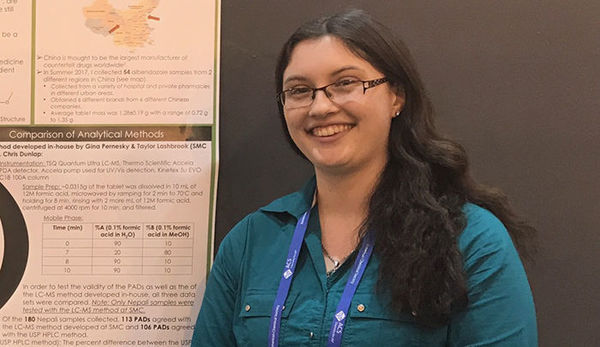
Heather DiLallo Pine, a 2020 Notre Dame chemical engineering graduate and 2019 chemistry graduate of Saint Mary’s College, has successfully revealed the 3D crystal structure of albendazole, water, and a tosylate salt. Her work has been published in the Cambridge Crystallographic Data Centre's Cambridge Structural Database with Pine as first author.
A crystal is a solid material whose atoms are arranged to form symmetrical external faces. Examples of common crystals are table salt, sugar, and diamonds. Pine’s crystal structure has the important real-world application of helping to determine if a medicine is genuine, substandard, or counterfeit.
Her accomplishment is significant for an undergraduate student, said Toni Barstis, the Saint Mary’s chemistry professor who worked with Pine on the project that led to the discovery. “While there are approximately one million crystal structures in the Cambridge Structural Database, most of these structures have been determined by graduate students and those with PhDs, not undergraduates,” Barstis said. “Growing and analyzing crystals requires specialized training and equipment, and can sometimes take years to produce a single viable crystal.

“Despite this, crystallography has been a key driver in our basic understanding of materials, genetics, and drug development; this has led to 28 Nobel Prizes, more than any other scientific field. Each new crystal structure discovered adds to our depth of scientific knowledge.”
The crystal that Pine produced is helping to illuminate the interaction of the anti-worming medicine albendazole and other drugs on a testing device called a PAD (paper analytical device) that helps detect counterfeit or substandard pharmaceuticals in developing nations. The PAD Project is a collaborative research effort between Saint Mary's and Notre Dame that enlists undergraduate students in developing and advancing the simple, inexpensive chemistry-based devices.
Pine became involved with the PADs project in 2016 as a Saint Mary’s student and traveled to China in 2017 and 2019 to collect samples of albendazole. Her crystallographic research was supervised by Barstis and Allen Oliver, a Notre Dame research professor, who are both listed as co-researchers of the crystal discovery. Pine’s travel and subsequent lab research was partially funded by the Liu Institute for Asia and Asian Studies.
After collecting samples, Pine tested the albendazole samples at Saint Mary’s to see how they reacted with cobalt on the paper analytical devices. One goal of the testing was to try to form a crystal, and in 2018 it happened. Pine discovered that the albendazole formed a crystal with water and a tosylate salt, which, in turn, reacted with cobalt to yield a colored result on the PAD.
The findings were submitted in 2019 to the Cambridge Crystallographic Data Centre's Cambridge Structural Database and were published in February.
“Better understanding the interaction of albendazole on the PADs allows us to move toward more tailored chemical tests for albendazole and other relevant pharmaceuticals,” Barstis explained. “Heather’s progress was an important step for our research.”
Pine now works as an associate scientist at Procter & Gamble in Cincinnati.
“After spending more than a year trying to get a viable crystal that would contribute to the project, I can't describe how much my eyes lit up when we analyzed the crystal and realized it was a new structure,” she said. “I'd never felt more like a true scientist than I did in that moment.”